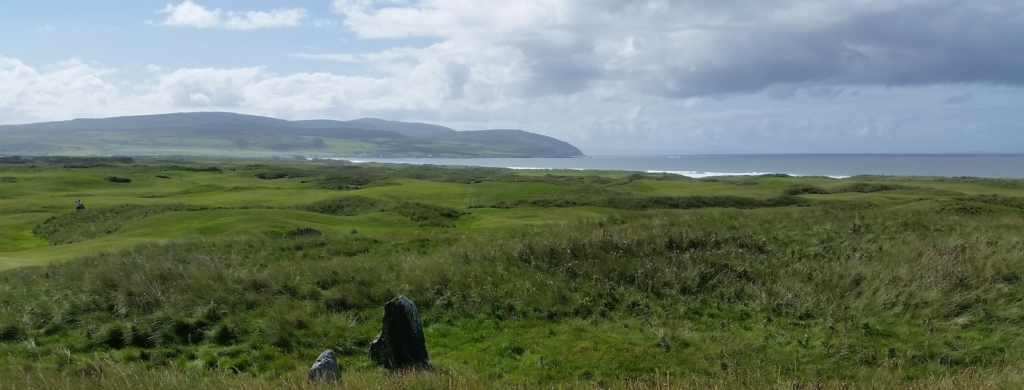
The last time I penned one of these updates was just after the weather had broken at the end of the longest dry spell I have seen during my tenure at Machrihanish Dunes. I think it has rained pretty much every day since! Although the changeable conditions we have seen over the last few weeks have obviously eased the pressure on us and our irrigation equipment, a lengthy spell of overcast weather with high levels of humidity bring with it its own set of problems. Greens surfaces that were already stressed from drought and compaction and were, in some places, suffering from a lack of nutrition (granular fertiliser can be difficult to apply if there is insufficient moisture available to wash it in) were suddenly placed into an environment where they faced pressure from disease pathogens, and we suffered some scarring around the edges of the greens from an outbreak of anthracnose. The progress of this disease can usually be slowed with a judicial application of nitrogen-based fertiliser, but if nitrogen levels are low and it remains unchecked, it can cause a lot of damage in a very short space of time. Of course, it is important not to throw too much nitrogen around during spells of muggy weather as this can invite similar attacks from fusarium patch. At times like this, it is very easy to get stuck right between a rock and a hard place!
Our old adversary, annual meadow grass, is particularly susceptible to attacks from both of these diseases, and as a result, it is very possible to use these outbreaks as a maintenance tool to put this least favoured grass on the back foot and to make room in the sward for us to plant new fescue or bentgrass seeds. That is all very good in theory, but of course, it is only really an acceptable practice if you have a large enough percentage of those preferential species in your sward in the first place. It is all too easy to underestimate the percentage of annual meadow grass that actually populates your greens, but a big disease attack will soon show you what you would be missing if you allowed these pathogens to run riot. In our case, and despite our best efforts over the last few years, we have far too much annual meadow grass to ignore and so we must–for the meantime anyway–be vigilant to ensure that these diseases do not get a good foothold. Unfortunately, spraying fungicides is the last thing we want to do. These chemical remedies are extremely good at halting the progress of diseases by killing the fungal pathogen, but in doing so, they kill everything else in the soil as well, immediately undoing all the good work that we have undertaken with our compost tea and biologically enhanced fertiliser programs. In this regard, we even have to be careful with what fertilisers we use, as those with a high salt index will also have a detrimental effect on the health of (both good and bad) soil bacteria. We were always taught, for instance, that iron products could be used as a mild fungicide, and I’m sure most of us once believed that the benefits we gained from using this element to our advantage in the war against disease were due to its acidifying properties. I now wonder whether its anti-fungal properties actually stem from its high salt content which would have had a toxic effect on not only the pathogen causing the disease outbreak but also on the health of many beneficial species in our soil. I used to use a lot of iron sulphate to control moss and disease when I worked at Machrie, and looking back, I can’t help but theorise about whether that had a contributory effect to the greens there suffering from outbreaks of red thread disease during periods of muggy weather. Did I help to cause that by accidentally killing off the bacteria that would have naturally fought for supremacy against the pathogen that caused that particular disease? Or maybe I’m being too hard on myself–maybe the outbreaks of red thread were more noticeable there because those greens had such a high percentage of fescue in them, and that is the grass species that suffers the most damage from red thread. Maybe one day I will manage to grow so much fescue in the greens at Machrihanish Dunes that I will have to start looking out for red thread here, too. That would be nice!
It is easy to punish yourself when disease pathogens, or indeed any number of outside influences, threaten the health of your greens. We greenkeepers try so hard to create ultimate golfing conditions while simultaneously attempting to maintain perfect plant health. But in order to present putting surfaces that are as good as we can muster on any given day, we inevitably have to run our greens on a nutritional knife-edge that does make them susceptible to attacks from all sorts of adversaries. When we do occasionally get caught out like I was recently by the bouts of anthracnose and fusarium, it weighs heavily on our minds, as we mull over how we could have been so stupid and then spend far too much time looking at small patches of affected turf that look enormous and career-threatening to us, but are, in reality, so minimal and unimportant that hardly anybody else even notices. We have had many compliments during the last two months for the condition of our putting surfaces, so we can’t be doing that much wrong!
Full recovery will happen- as long as we roll up our sleeves and put in the work!
A regular visitor complimented me just the other day, noting how well the tees had recovered from the recent dry spell in comparison to some areas of fairway which have taken a little longer to revert to full green cover. Maybe it wasn’t meant to be a compliment, but I took it as one because it is purely due to hard work on our part that these tees have recovered so well and will continue to improve still further over the course of the next few weeks. You will remember that we took the decision during May, June, and July to concentrate our watering efforts on greens and the tees that got the most play, therefore ensuring that we retained enough water at our groundwater source to avoid running the well points dry. I still maintain that we judged this very well, but this policy did mean that some of the back tees did not receive a drop of irrigation water throughout the whole summer and as a result, went completely brown.
Once the rain came and normality was resumed, we immediately sprayed our tees with a combination of penetrant and matrix wetting agents and took our Toro Procore aerator over them to relieve any compaction and to open up a grid pattern of inch-deep, 19mm-wide holes. We then spread the best quality grass seed into these holes and top-dressed the tees heavily with an 80/20 sand/soil mix, before leveling them with the back of a rake. As you will know if you have played at Machrihanish Dunes, a lot of our tees are very small, and it is therefore impossible to top-dress them with a machine. The only option available to us is to use shovels and spread by hand, which is time-consuming and labour-intensive, but in circumstances like this, you just to have to roll up your sleeves and get on with it (in fairness, it was mostly Craig and Sebastian’s sleeves rather than mine!).
All this effort that everybody gladly put in was rewarded with a spell of weather which has been extremely conducive to germinating grass seed and therefore, the results we achieved were as good as we could have ever hoped for. Never ones to rest on our laurels though, we waited until two weeks after the first seedlings had popped through, applied some fertiliser to help bring them on to maturity, and repeated the whole process over again. This second batch of seedlings has yet to germinate (they were only seeded out a week ago), but the perfect growing weather has continued and looks set to last for long enough to ensure that we are just as successful this time as we were a few weeks ago.


Sometimes you can undertake a mission like this only to be thwarted by weather that makes success impossible, but on this occasion, it looks like we were justified in spending so much of our resources in an attempt to improve tees that were looking a bit sorry for themselves. We are very hopeful that we can retain a large percentage of the new grass that we have planted, which will, of course, be of superior quality to that which died out during the weeks of dry weather. The end result will be tees that are better than they ever have been, but that is just what we deserve really considering how hard we worked to achieve this.
Competition season…it is nearly over already!
Two majors have come and gone since I last wrote one of these reports. Gary Shepperd retained our Cub Championship in the rain and in some style, producing 36 holes of strokeplay golf that the rest of the field could not handle. If he shot 70,72 for a 142 total on two good days he would rightly expect to win, so he was never going to be caught after scoring that well in persistent rain. Steven Gilmour won the handicap championship on the same day.
The Black Sheep Cup was played in even more inclement weather, but Jonathan Bruce still managed to amass 36 points, which was enough to emerge victoriously. Congratulations to all of you if you’re reading this!

Next up is our Autumn Pairs competition on October 6th, which is always well attended. Please contact Lorna or Peter at the Golf House at your earliest opportunity if you wish to compete! This year, we are combining the Autumn Pairs with our annual member’s evening, which will see us host a buffet at The Ugadale Hotel with entertainment to follow. I am not sure yet exactly what that entertainment will involve, but it’ll probably include some darts and a quiz because that always seems to go down well and we are always keen not to mess with a winning formula. If anybody has any suggestions, though, for something that might be light-hearted fun, please do bring them to me. If you wish to attend the members evening and you would like to book a table or receive more information, just give Lorna a call at the Golf House on 01586810058.

